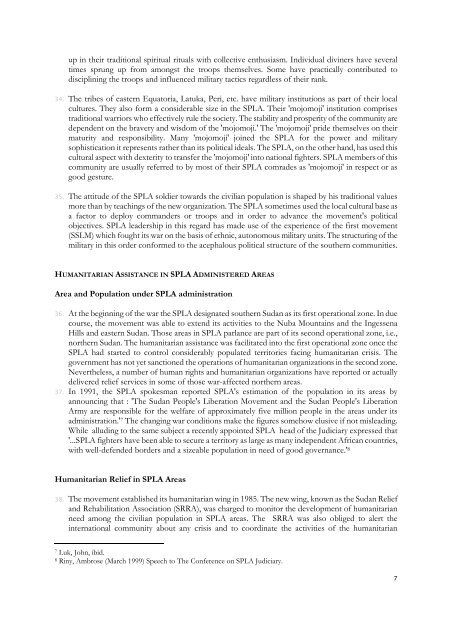105 - Sudan - Approaches to Armed Groups Kuol ... - The ICHRP
105 - Sudan - Approaches to Armed Groups Kuol ... - The ICHRP
105 - Sudan - Approaches to Armed Groups Kuol ... - The ICHRP
Create successful ePaper yourself
Turn your PDF publications into a flip-book with our unique Google optimized e-Paper software.
up in their traditional spiritual rituals with collective enthusiasm. Individual diviners have several<br />
times sprung up from amongst the troops themselves. Some have practically contributed <strong>to</strong><br />
disciplining the troops and influenced military tactics regardless of their rank.<br />
34. <strong>The</strong> tribes of eastern Equa<strong>to</strong>ria, Latuka, Peri, etc. have military institutions as part of their local<br />
cultures. <strong>The</strong>y also form a considerable size in the SPLA. <strong>The</strong>ir 'mojomoji' institution comprises<br />
traditional warriors who effectively rule the society. <strong>The</strong> stability and prosperity of the community are<br />
dependent on the bravery and wisdom of the 'mojomoji.' <strong>The</strong> 'mojomoji' pride themselves on their<br />
maturity and responsibility. Many 'mojomoji' joined the SPLA for the power and military<br />
sophistication it represents rather than its political ideals. <strong>The</strong> SPLA, on the other hand, has used this<br />
cultural aspect with dexterity <strong>to</strong> transfer the 'mojomoji' in<strong>to</strong> national fighters. SPLA members of this<br />
community are usually referred <strong>to</strong> by most of their SPLA comrades as 'mojomoji' in respect or as<br />
good gesture.<br />
35. <strong>The</strong> attitude of the SPLA soldier <strong>to</strong>wards the civilian population is shaped by his traditional values<br />
more than by teachings of the new organization. <strong>The</strong> SPLA sometimes used the local cultural base as<br />
a fac<strong>to</strong>r <strong>to</strong> deploy commanders or troops and in order <strong>to</strong> advance the movement's political<br />
objectives. SPLA leadership in this regard has made use of the experience of the first movement<br />
(SSLM) which fought its war on the basis of ethnic, au<strong>to</strong>nomous military units. <strong>The</strong> structuring of the<br />
military in this order conformed <strong>to</strong> the acephalous political structure of the southern communities.<br />
HUMANITARIAN ASSISTANCE IN SPLA ADMINISTERED AREAS<br />
Area and Population under SPLA administration<br />
36. At the beginning of the war the SPLA designated southern <strong>Sudan</strong> as its first operational zone. In due<br />
course, the movement was able <strong>to</strong> extend its activities <strong>to</strong> the Nuba Mountains and the Ingessena<br />
Hills and eastern <strong>Sudan</strong>. Those areas in SPLA parlance are part of its second operational zone, i.e.,<br />
northern <strong>Sudan</strong>. <strong>The</strong> humanitarian assistance was facilitated in<strong>to</strong> the first operational zone once the<br />
SPLA had started <strong>to</strong> control considerably populated terri<strong>to</strong>ries facing humanitarian crisis. <strong>The</strong><br />
government has not yet sanctioned the operations of humanitarian organizations in the second zone.<br />
Nevertheless, a number of human rights and humanitarian organizations have reported or actually<br />
delivered relief services in some of those war-affected northern areas.<br />
37. In 1991, the SPLA spokesman reported SPLA's estimation of the population in its areas by<br />
announcing that : '<strong>The</strong> <strong>Sudan</strong> People's Liberation Movement and the <strong>Sudan</strong> People's Liberation<br />
Army are responsible for the welfare of approximately five million people in the areas under its<br />
administration.' 7 <strong>The</strong> changing war conditions make the figures somehow elusive if not misleading.<br />
While alluding <strong>to</strong> the same subject a recently appointed SPLA head of the Judiciary expressed that<br />
'...SPLA fighters have been able <strong>to</strong> secure a terri<strong>to</strong>ry as large as many independent African countries,<br />
with well-defended borders and a sizeable population in need of good governance.' 8<br />
Humanitarian Relief in SPLA Areas<br />
38. <strong>The</strong> movement established its humanitarian wing in 1985. <strong>The</strong> new wing, known as the <strong>Sudan</strong> Relief<br />
and Rehabilitation Association (SRRA), was charged <strong>to</strong> moni<strong>to</strong>r the development of humanitarian<br />
need among the civilian population in SPLA areas. <strong>The</strong> SRRA was also obliged <strong>to</strong> alert the<br />
international community about any crisis and <strong>to</strong> coordinate the activities of the humanitarian<br />
7 Luk, John, ibid.<br />
8 Riny, Ambrose (March 1999) Speech <strong>to</strong> <strong>The</strong> Conference on SPLA Judiciary.<br />
7
















